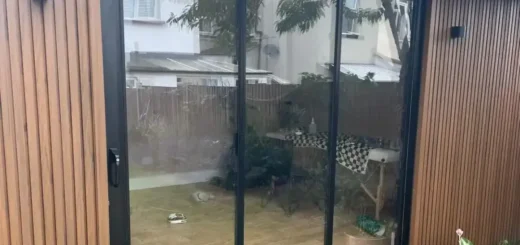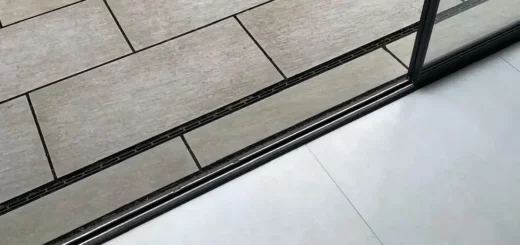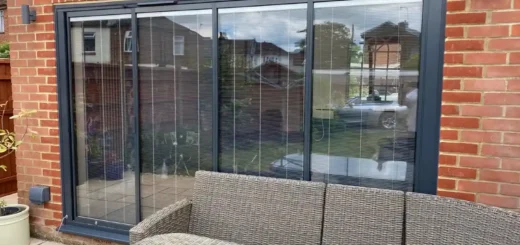White External Bifold Doors Guide: Frames, Design Tips & More
Table of Contents
What Are White External Bifold Doors?
White external bifold doors fold back on themselves using a concertina mechanism, opening up entire wall sections to connect your home with the garden. Each panel slides along a top track whilst pivoting on hinges, allowing you to stack the glass panels neatly to one side of the opening. Unlike sliding patio doors that move horizontally or French doors that swing outwards, bi-folding doors can open up apertures spanning several metres without requiring clearance space in front of the door opening.
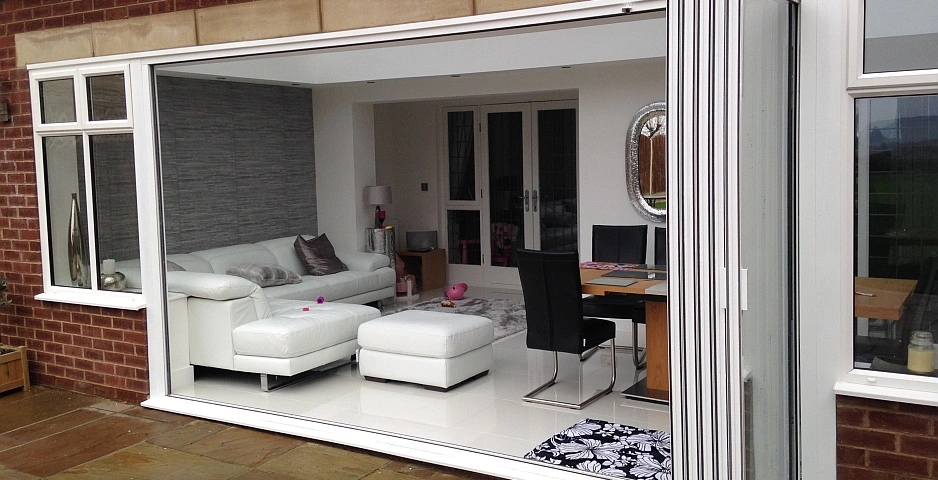
Frame Materials for White External Bifold Doors
Aluminium frames dominate the external bifold doors market due to their strength-to-weight ratio and resistance to warping. Powder coating produces a durable white finish that won’t yellow or fade like traditional paint, whilst the narrow sight lines create a contemporary appearance. Thermally broken aluminium frames include polyamide strips that prevent cold transfer from outside to inside, which is important for meeting modern building regulations.
White uPVC bifold doors cost substantially less than aluminium alternatives but offer bulkier frames that reduce the glass area. Multi-chambered uPVC profiles provide good insulation properties, though the material can become brittle in extreme cold and may show stress cracking around hinges after several years of use. White uPVC maintains its colour better than darker shades but can show dirt and weathering more readily.
Glass Options and White Frame Combinations
Standard double glazing in white exterior bifold doors typically measures as little as 20mm thick overall, comprising two 4mm glass panes separated by a 12mm cavity filled with argon gas. Toughened safety glass becomes mandatory for panels exceeding certain dimensions, particularly in ground-floor installations where impact resistance proves critical for family safety.
Width Configurations for White External Bifold Doors
Two-panel configurations suit smaller openings where you want maximum light without the expense of larger installations, though you lose the eye catching opening effect of wider spans. Three and four-panel arrangements prove most popular for typical family homes, creating openings wide enough for garden furniture to pass through whilst remaining proportionate to room sizes.
Six-panel white bifold doors can span openings approaching 5 metres wide, turning kitchen-diners or living areas into genuine indoor-outdoor living areas during warmer months. The weight of multiple glass panels requires robust top tracks and additional support posts for spans exceeding certain widths, which structural engineers specify based on your property’s construction and local wind loading requirements.
White External Bifold Doors and Your Home’s Exterior
Matching your new white bifold doors to your property’s existing features prevents the mismatched appearance that can devalue your home and create visual confusion.
Matching White Frames to Existing Windows
Brilliant white, off-white, and cream all masquerade under the generic term “white” yet appear startlingly different when placed side by side. Your existing window frames might sport a warm ivory tone that clashes with the stark brilliance of modern powder-coated aluminium, or your fascia boards could carry a grey undertone that makes new installations look yellow by comparison.
RAL colour references provide the most reliable method for matching whites across different materials and manufacturers. RAL 9016 Traffic White offers the purest bright white, whilst RAL 9001 Cream White carries subtle warm undertones that complement traditional masonry and timber details. Many installers carry colour samples showing how these standard whites appear against common building materials, allowing you to check compatibility before committing to purchase.
White External Bifold Doors with Brick and Rendered Walls
Red brick creates natural warmth that pairs beautifully with white external bifold doors, particularly when mortar joints use pale sand or lime-based pointing that echoes the door frames. The contrast helps define the door opening whilst the white brightens north-facing areas that might otherwise appear gloomy during winter months.
Rendered walls in grey or off-white tones provide neutral backdrops that allow white door frames to become focal points without competing for attention. Smooth renders highlight the clean lines of contemporary door designs, whilst textured finishes like pebbledash or roughcast suit more traditional installations where garden bifold doors need to complement existing architectural details rather than dominate them.
Charcoal grey, navy blue, or black exterior walls create striking backdrops that make white exterior bifold doors appear larger and more prominent than they would against lighter backgrounds. This high contrast works particularly well on contemporary homes where bold colour choices reflect modern architectural confidence.
Natural Stone Combinations with White External Bifold Doors
Cotswold limestone’s honey tones provide gentle contrast against white door frames whilst maintaining the relaxed country aesthetic that many rural properties depend upon. The stone’s natural variation means no two installations look identical, creating unique character that mass-produced materials cannot replicate.
Welsh slate’s blue-grey colouration offers more pronounced contrast that suits both traditional Welsh cottages and contemporary barn conversions where white external bifold doors bridge old and new architectural elements. Sandstone varieties from Yorkshire or the Forest of Dean carry warmer tones that prevent white frames from appearing too clinical against natural textures.
Planning Your Outdoor Space Around White External Bifold Doors
Your patio design and garden layout need careful planning to make the most of the wide openings these doors create.
Patio Layout and White Bifold Door Openings
Patio width should exceed your door opening by at least one metre on each side to avoid creating a cramped transition between indoor and outdoor spaces. A three-metre door opening requires a minimum five-metre patio width, though six metres provides more comfortable proportions for outdoor dining and entertaining. Narrower patios force furniture against the house wall, reducing usable space and creating an awkward corridor effect.
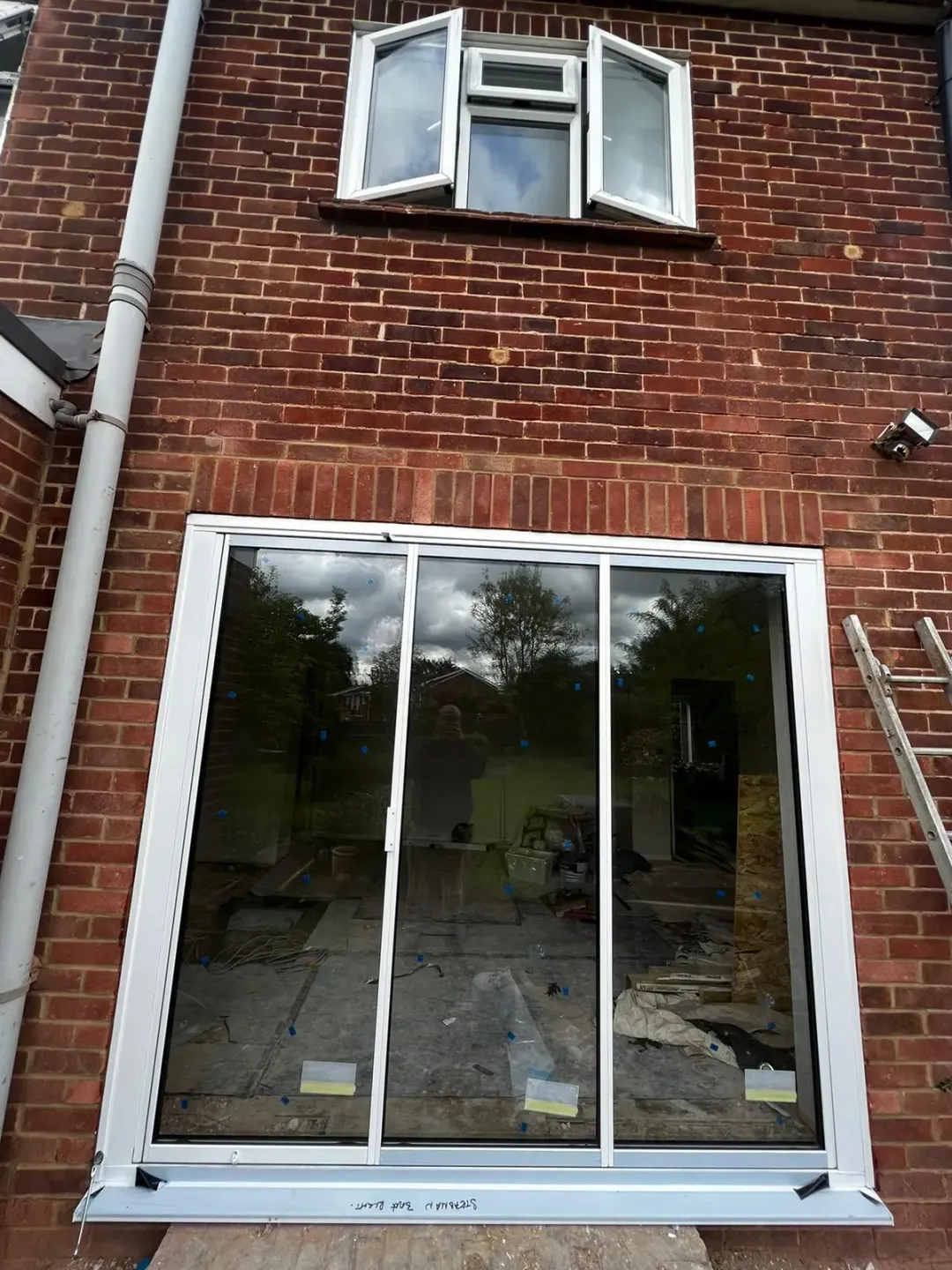
Garden Furniture Colours for White Door Schemes
Natural teak weathers to silver-grey tones that complement white door frames without competing for attention, whilst its durability suits the exposure that comes with permanent outdoor placement. Powder-coated aluminium furniture in charcoal or anthracite provides contemporary styling that works well with the clean lines of modern outdoor bifold doors, though lighter colours like sage green or soft blue create gentler contrasts for traditional properties.
Rattan and wicker furniture in natural honey tones bridge the gap between indoor comfort and outdoor practicality, particularly when paired with neutral cushions in beige, taupe, or soft grey. Avoid bright furniture colours that fight with garden planting or create visual chaos when viewed through large glass panels from inside your home.
Decking Materials That Complement White Frames
Composite decking in grey or brown tones provides low-maintenance surfaces that won’t fade or splinter, important when children play near white external bifold doors where safety becomes paramount. The consistent colouring of composite materials creates clean lines that suit contemporary installations, though the artificial appearance may jar with period properties where natural materials would be more appropriate.
Hardwood decking ages gracefully when left untreated, developing silver patina that harmonises with white door frames whilst maintaining the natural character that many homeowners prefer. Iroko, teak, and accoya offer different grain patterns and weathering characteristics that suit various architectural styles and budget constraints.
Landscaping Colours and White Bifold Doors
Purple and silver foliage plants like lavender, rosemary, and sage create sophisticated palettes that complement white exterior bifold doors without overwhelming their clean appearance. These Mediterranean species thrive in the shelter and reflected heat that comes from proximity to large glazed openings, making them practical as well as attractive choices for door-adjacent planting.
Green and white planting schemes using hostas, ferns, and white-flowering shrubs like viburnum or philadelphus create fresh, timeless combinations that work across seasons. Evergreen structure plants provide year-round interest when deciduous species lose their leaves, preventing winter gardens from appearing bare when viewed through slim profile bifold doors from heated indoor spaces.
Interior Design with White External Bifold Doors
Large expanses of white framing and glass change how your interior spaces look and feel throughout the day.
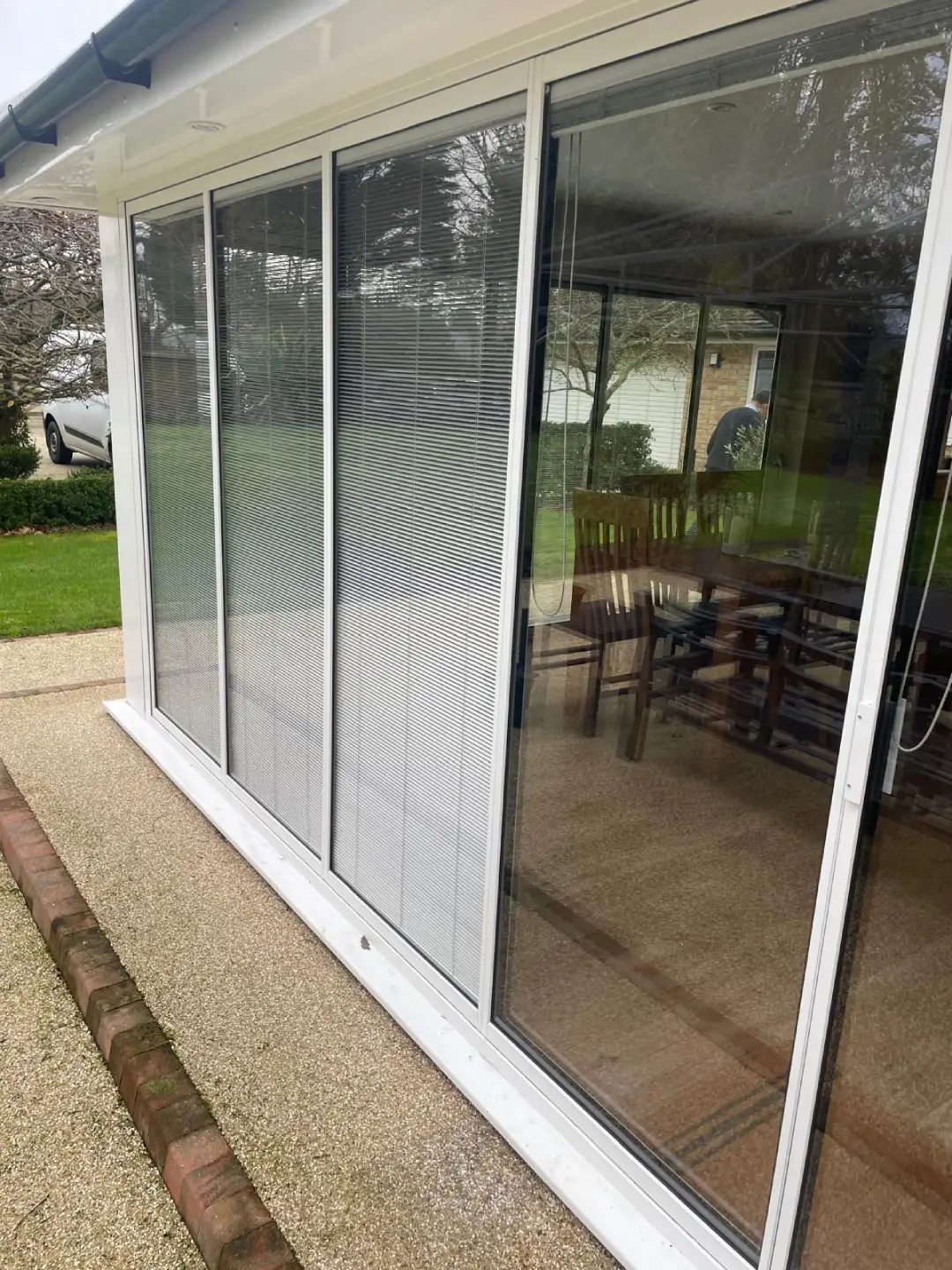
Room Colours That Work with White External Frames
Warm neutrals like mushroom, taupe, and soft grey provide calming backdrops that allow white external bifold doors to become the focal point without creating stark contrasts that tire the eye. These muted tones work particularly well in north-facing rooms where the bright white frames help bounce available light around the space, making smaller rooms feel more spacious than bold colours would achieve.
Cool blues and greens echo the garden colours visible through the glazing, creating visual continuity between interior and exterior spaces that feels natural rather than forced. Sage green walls complement the white frames whilst referencing the foliage beyond, whilst soft blues work well in bedrooms and bathrooms where the calming effect suits the room’s purpose.
Flooring Transitions with White Bifold Doors
Stone flooring that continues from inside to outside creates uninterrupted surfaces that make rooms feel larger when bi-fold doors stand open during warmer weather. Limestone, travertine, and porcelain tiles all suit this approach, though underfloor heating becomes essential for natural stone to remain comfortable during winter months when doors stay closed.
Engineered wood flooring stops at the threshold, requiring complementary materials outside to prevent water damage from rain and condensation. The junction needs careful sealing and weatherproofing, with threshold strips providing the necessary barrier whilst maintaining a neat appearance that doesn’t jar with the clean lines of white door frames.
Window Treatments for White Bifold Door Rooms
Curtains require extended tracks that clear the full width of opened doors, often spanning entire walls to accommodate folded panels stacked to one side. Lightweight fabrics in natural fibres like linen or cotton suit the relaxed aesthetic that white exterior bifold doors create, whilst avoiding synthetic materials that might appear cheap against quality door installations.
Plantation shutters offer precise light control without requiring wall space for opened curtains, their louvred design echoing the linear elements of door frames whilst providing privacy when needed. Internal blinds built into double glazed units stay protected from moisture and damage, though they add cost and complexity to door specifications whilst reducing the clean appearance that attracts many buyers to slim sightline bifold doors.
Furniture Placement in White External Bifold Door Rooms
Seating arrangements work best when positioned to take advantage of garden views without blocking the door opening when panels fold back. L-shaped sofas placed perpendicular to the doors create conversation areas that include both interior comfort and outdoor vistas, whilst avoiding the corridor effect that comes from aligning furniture parallel to long wall openings.
Dining tables need sufficient space for chair movement without conflicting with door operation, typically requiring at least one metre clearance between table edge and door track. Round tables often work better than rectangular ones in rooms with white external bifold doors, as their curved edges create better traffic flow around the space whilst maintaining the relaxed atmosphere that large glazed openings bring to family dining areas.
About SunSeeker Doors
With over 20 years of experience, SunSeeker Doors remains at the forefront of door design with our quality-tested patio doors and related products, including the bespoke UltraSlim aluminium slide and pivot door system, Frameless Glass Doors, and Slimline Sliding Glass Doors. All of our doors are suitable for both internal and external use.
To request a free quotation, please use our online form. You may also contact 01582 492730, or email info@sunseekerdoors.co.uk if you have any questions.


